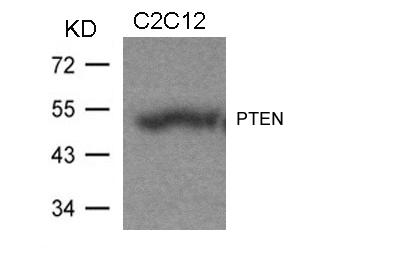Product Detail
Product NamePTEN(Ab-370) Antibody
Host SpeciesRabbit
ClonalityPolyclonal
PurificationAntibodies were produced by immunizing rabbits with synthetic peptide and KLH conjugates. Antibodies were purified by affinity-chromatography using epitope-specific peptide.
ApplicationsWB IHC
Species ReactivityHu Ms Rt
SpecificityThe antibody detects endogenous level of total PTEN protein.
Immunogen TypePeptide-KLH
Immunogen DescPeptide sequence around aa.368~372 (D-V-S-D-N) derived from Human PTEN.
Target NamePTEN
ConjugateUnconjugated
Other NamesMMAC1; Mutated in multiple advanced cancers 1; Protein-tyrosine phosphatase PTEN; TEP1;
Accession NoSwiss-Prot: P60484
NCBI Protein: NP_000305.3
Uniprot
P60484
Gene ID
5728;
Concentration1.0mg/ml
FormulationSupplied at 1.0mg/mL in phosphate buffered saline (without Mg2+ and Ca2+), pH 7.4, 150mM NaCl, 0.02% sodium azide and 50% glycerol.
StorageStore at -20°C for long term preservation (recommended). Store at 4°C for short term use.
Application Details
Predicted MW: 54kd
Western blotting: 1:500~1:1000
Immunohistochemistry: 1:50~1:100
Western blot analysis of extracts from C2C12 cells using PTEN(Ab-370) Antibody #21057.
Immunohistochemical analysis of paraffin-embedded human breast carcinoma tissue using PTEN(Ab-370) Antibody #21057(left) or the same antibody preincubated with blocking peptide(right).
Tumor suppressor. Acts as a dual-specificity protein phosphatase, dephosphorylating tyrosine-, serine- and threonine-phosphorylated proteins. Also acts as a lipid phosphatase, removing the phosphate in the D3 position of the inositol ring from phosphatidylinositol 3,4,5-trisphosphate, phosphatidylinositol 3,4-diphosphate, phosphatidylinositol 3-phosphate and inositol 1,3,4,5-tetrakisphosphate with order of substrate preference in vitro PtdIns(3,4,5)P3 > PtdIns(3,4)P2 > PtdIns3P > Ins(1,3,4,5)P4. The lipid phosphatase activity is critical for its tumor suppressor function. Antagonizes the PI3K-AKT/PKB signaling pathway by dephosphorylating phosphoinositides and thereby modulating cell cycle progression and cell survival. The unphosphorylated form cooperates with AIP1 to suppress AKT1 activation. Dephosphorylates tyrosine-phosphorylated focal adhesion kinase and inhibits cell migration and integrin-mediated cell spreading and focal adhesion formation. May be a negative regulator of insulin signaling and glucose metabolism in adipose tissue.
Al-Khouri AM, et al. (2005). J Biol Chem. 280 (42):35195-35202.
Miller SJ, et al. (2002). FEBS Lett. 528 (1-3): 145-153.
Torres J, et al. (2001). J Biol Chem.276 (2): 993-998.
Vazquez F, et al. (2000). Mol Cell Biol.20 (14): 5010-5018.
If you have published an article using product 21057, please notify us so that we can cite your literature.
et al,Molecular Mechanisms of Bladder Outlet Obstruction in Transgenic Male Mice Overexpressing Aromatase (Cyp19a1).In Am J Pathol on 2011 Mar by Wei Lin, Nafis A Rahman,et al..PMID:21356374
, (2011),
PMID:
21356374
et al,Effect of adenovirus-mediated PTEN gene on ulcerative colitis-associated colorectal cancer. In Int J Colorectal Dis on 2013 Aug by Zhi Li, Gong Xiang Liu, et al..PMID:
23516074
, (2013),
PMID:
23516074




 Yes
Yes



